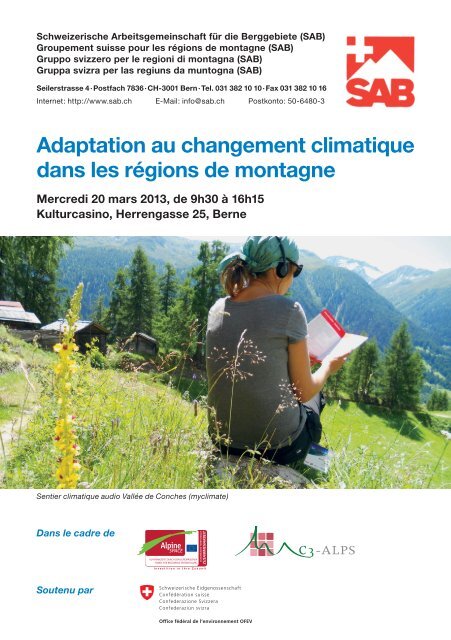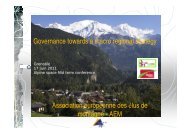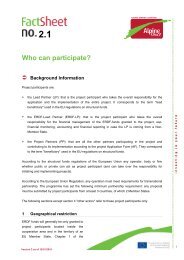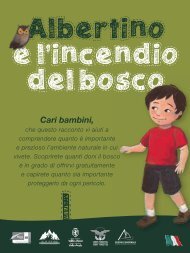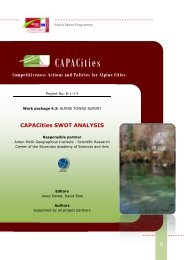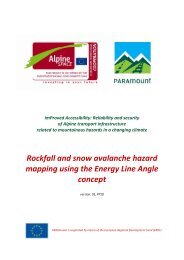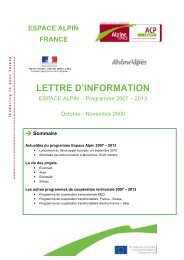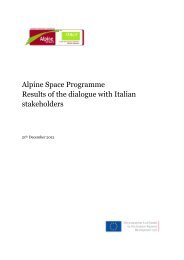Adaptation au changement climatique dans les régions de montagne
Adaptation au changement climatique dans les régions de montagne
Adaptation au changement climatique dans les régions de montagne
- No tags were found...
You also want an ePaper? Increase the reach of your titles
YUMPU automatically turns print PDFs into web optimized ePapers that Google loves.
Contexte et but <strong>de</strong> la journée d’étu<strong>de</strong>Les <strong>changement</strong>s <strong>climatique</strong>s vont continuer leur évolution, <strong>au</strong>ssi bien <strong>au</strong> nive<strong>au</strong> globalqu’en Suisse. La h<strong>au</strong>sse <strong>de</strong>s températures ne peut plus être évitée, mais tout <strong>au</strong> pluslimitée. Ainsi <strong>les</strong> adaptations <strong>au</strong> <strong>changement</strong> <strong>climatique</strong> <strong>de</strong>viennent <strong>de</strong> plus en plusnécessaires. Ce phénomène concerne particulièrement <strong>les</strong> régions <strong>de</strong> <strong>montagne</strong> quiseront touchées <strong>au</strong>ssi bien par la h<strong>au</strong>sse <strong>de</strong>s températures que par l’évolution <strong>de</strong>s précipitations.Les conséquences <strong>de</strong> cette évolution concernent notamment l’économie,le milieu naturel et la société.En mars 2012, le Conseil fédéral a adopté sa stratégie pour l’adaptation <strong>au</strong> <strong>changement</strong><strong>climatique</strong>. Ce document sert <strong>de</strong> cadre pour <strong>les</strong> mesures décidées par la Confédération.Les principa<strong>les</strong> conséquences pour <strong>les</strong> régions <strong>de</strong> <strong>montagne</strong> sont liées à un risqued’inondation accru, à une <strong>au</strong>gmentation <strong>de</strong>s glissements <strong>de</strong> terrains, à l’apparition <strong>de</strong>pério<strong>de</strong>s <strong>de</strong> sécheresse plus longues ou encore à une diminution <strong>de</strong> l’enneigement<strong>de</strong> certaines régions. Afin <strong>de</strong> limiter <strong>les</strong> effets <strong>de</strong> cette évolution, et <strong>au</strong>ssi pour en tirerparti, tous <strong>les</strong> acteurs concernés ont intérêt à agir ensemble (Confédération, cantons,communes, organisations, privés).Cette rencontre vise à favoriser <strong>les</strong> échanges et le dialogue entre <strong>les</strong> différents acteursconcernés. En plus <strong>de</strong> mesures prises par la Confédération, <strong>de</strong>s étu<strong>de</strong>s scientifiques,ainsi que <strong>de</strong>s mesures pratiques provenant <strong>de</strong>s régions <strong>de</strong> <strong>montagne</strong>, seront présentées<strong>au</strong> public. Les possibilités d’action seront <strong>au</strong> centre <strong>de</strong>s débats et <strong>de</strong>s présentations<strong>de</strong> cette journée.Public cibleCette journée d’étu<strong>de</strong> s’adresse principalement <strong>au</strong>x:• Responsab<strong>les</strong>canton<strong>au</strong>xetcommun<strong>au</strong>x• Politiciensactifs<strong>au</strong>nive<strong>au</strong>cantonaletcommunal• Managersrégion<strong>au</strong>x• Expertsissusd’universités,<strong>de</strong>sH<strong>au</strong>teséco<strong>les</strong>,d’organisationset<strong>de</strong>milieuxprivés(organisations touristiques, hôtellerie, milieux <strong>de</strong> la rest<strong>au</strong>ration et <strong>de</strong>s transports)Langues utiliséesAllemand et français avec traduction simultanée.
Programme09h30 Arrivée et café10h00 Salutation et introduction à la journéeP<strong>au</strong>l Filliger, Chef <strong>de</strong> section rapports <strong>climatique</strong>s et adaptation <strong>au</strong>x<strong>changement</strong>s, OFEV; Thomas Egger, Groupement suisse pour <strong>les</strong> régions<strong>de</strong> <strong>montagne</strong> (SAB)10h05 Les <strong>changement</strong>s <strong>climatique</strong>s <strong>dans</strong> <strong>les</strong> régions <strong>de</strong> <strong>montagne</strong> suissesMischa Croci Maspoli, Head Climate Information, MeteoSuisse10h20 <strong>Adaptation</strong>s <strong>au</strong> <strong>changement</strong> <strong>climatique</strong>: la stratégie du Conseil fédéralRoland Hohmann, Coordination stratégie d’adaptation, section rapports<strong>climatique</strong>s et adaptation <strong>au</strong>x <strong>changement</strong>s, OFEV10h40 <strong>Adaptation</strong> <strong>au</strong> nive<strong>au</strong> cantonal: la stratégie du canton d’UriChristian Wüthrich, Responsable Projet «Changement <strong>climatique</strong>», Directionpour l’environnement, canton Uri10h55 Discussion sur <strong>les</strong> stratégies d’adaptation11h1511h3011h45Les effets du <strong>changement</strong> <strong>climatique</strong> sur l’agriculture <strong>de</strong> <strong>montagne</strong>Jürg Fuhrer, Responsable du groupe «hygiène <strong>de</strong> l’air/climat», AgroscopeAgriculture et stratégies d’adaptation <strong>dans</strong> le canton du JuraVéronique Frutschi, Conseillère Fondation Rurale Interjurassienne (à confirmer)Discussion <strong>au</strong> sujet <strong>de</strong> l’agriculture12h00 Apéritif dînatoire13h00 Mesures d’adaptation pour le tourisme alpinBruno Abegg, Professeur Institut <strong>de</strong> Géographie, Université Innsbruck13h15Comment une <strong>de</strong>stination touristique fait face <strong>au</strong> <strong>changement</strong> <strong>climatique</strong>Mathias Ulrich, Directeur <strong>de</strong> Sattel Hochstuckli AG13h30 Discussion sur le tourisme13h50 Influence du <strong>changement</strong> <strong>climatique</strong> sur <strong>les</strong> dangers naturels <strong>dans</strong> <strong>les</strong> AlpesHugo Raetzo, Experts ouvrages <strong>de</strong> protection, section Glissements <strong>de</strong> terrain,avalanches et forêts protectrices, OFEV14h05 Le <strong>changement</strong> <strong>climatique</strong> menace GuttannenHans Abplanalp, Prési<strong>de</strong>nt <strong>de</strong> la commune <strong>de</strong> Guttannen (BE)14h20 Discussion sur <strong>les</strong> dangers naturels14h40 P<strong>au</strong>se15h1016h10Discussion: réflexions <strong>au</strong> sujet <strong>de</strong> la journée et besoins afin <strong>de</strong> concrétiser <strong>de</strong>smesures pour faire face <strong>au</strong> <strong>changement</strong> <strong>climatique</strong> <strong>au</strong> nive<strong>au</strong> pratique et politique.Modération Thomas Egger – Participants: P<strong>au</strong>l Filliger (Chef <strong>de</strong> sectionrapports <strong>climatique</strong>s et adaptation <strong>au</strong>x <strong>changement</strong>s, OFEV), Franz Gnos(Conseiller municipal Silenen, prési<strong>de</strong>nt du rése<strong>au</strong> <strong>de</strong> communes Allinance<strong>dans</strong> <strong>les</strong> Alpes), Joseph O<strong>de</strong>rmatt (Directeur Association régionale Rigi-Mythen), Hansjörg Trachsel (Conseiler-exécutif canton <strong>de</strong>s Grisons)ConclusionThomas Egger, SAB
Coûts et délai d’inscriptionLa participation à cette rencontre est gratuite; le délai d’inscription est fixé <strong>au</strong> 8 mars 2013.PlanCheminementAvec <strong>les</strong> transports publiquesDepuis la gare principale <strong>de</strong> Berne prenez le tram ligne 6 (direction Worb), tram ligne 7(direction Ostring) ou tram ligne 8 (direction Saali) et sortez à l’arrêt Zytglogge.Avec la voitureSur l’<strong>au</strong>toroute A6 Berne – Thoune – Interlaken prenez la sortie Bern – Ostring, suivez <strong>les</strong>panne<strong>au</strong>x «Zentrum» et «Parkh<strong>au</strong>s Casino» via Ostring – Thunstrasse – Jungfr<strong>au</strong>strasse– Marienstrasse – Kirchenfeldbrücke.


